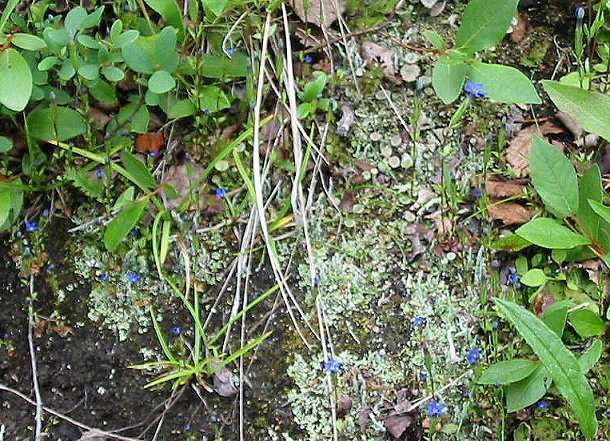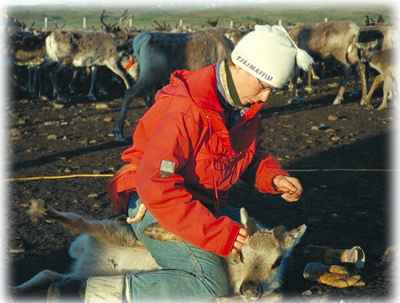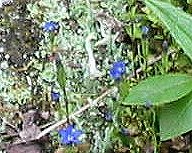
Preparing for the reindeer branding
We met two friendly Sami fellows in the midst of a moor on our way from
Sälkastugan to Kebnekajse. We got to talking, standing there on
the
level moor, the way you do when you meet people just about once a day
--
at most. You meet other people of course in the STF cabins at the end
of
the day's walk, but very rarely during the day, at least we didn't way
back in those days. The two Samis were big reindeer owners (one of them
named Blind, I believe) and they told us the reindeer
were being rounded up over the past few days for the branding that very
night. They
offered to come and pick us up in the evening if we would go south to
Singistugan instead of going straight to
Kebnekajse turiststation, and they
would come and pick us up and take us to the reindeer branding site
that very evening.
The mountain is moving
This gave us the explanation for the wondrous experience we had had
earlier that same day. We had been heading south, walking on the
eastern
side of a long valley with a long low mountain side on our right, on
the
other side of the valley. There was very ragged 'blockmark' (nothing
but
big rocks to walk on for kilometers) where we were walking and you had
to pay attention to where you put your feet as you skipped from one
rock to the next one. One of us looked up at one point though and
exclaimed in wild surprise - Look, the mountain is moving! All four of
us stopped and looked and it was a sight one never forgets. The
mountain
side was completely covered with the stately animals, moving at a
steady
slow pace towards the south, most certainly led on by the Sami huskies
who are masters at the art of rounding up reindeer and taking them to
wherever they are supposed to be going. (Today, deep sigh, this is done
by helicopters!)
Singistugan and a wild walk
In the evening the two Sami reindeer owners came by the cabin, as
agreed on, and we set out on a wild running walk across the plateaus, uphill
and downhill. My father, who has never been
anything like an athlete, couldn't keep up with the pace too well and
we asked our new friends if they could possibly slow down a bit. They
looked at us all surprised and said "But this is slow walking!"
As to where exactly the branding event was, I really don't
know. Looking closely at my map it seems as if it must
have been east of Singistugan. To the west there is the big
stream, Tjäktjajokk (jokk or jåkkå = stream), and we
definitely did not wade across a jokk that evening. I cannot remember
where the sun was as we were running across the hills and plateaus. It
would of course have been close to the north, but that is just what I
know now, since the sun is due north at midnight.
At the time, I didn't even think of where the sun was. I look for a
site
on my map between a mountain drop and a lake and I find a lake called
Jierttajaure (jiertta = the round mountain; jaure = lake) which could
well have been the place, a few kilometers east of Singistugan at the
foot of Unna Jierttas (unna = small - so the small round mountain).
(My thanks to Ulf
Mjörnmark
for some of the Sami vocabulary!)
The reindeer branding
It is an understatement to say that it was the experience of a
lifetime. It is an event that will stay forever clear in my mind - the
colors, the shouting and the movements throughout the night that was as
bright as the day just before sunset, and the never-ceasing sound like
distant thunder of the reindeer - running, running,
their hooves drumming on the muddied ground. The branding area was
closed in
on one side by the steep mountain, on the opposite side by the lake, at
the far end by a low man-made wall, and at the entrance by wildly
barking dogs, 7 or 8 maybe, tied to posts linked together by ropes all
across the opening, some stray pieces of clothing hung over the posts.
Whenever a reindeer stole off into freedom, a dog was let loose to go
in pursuit of the runaway. The husky would drive the reindeer
back into the fold in a couple of minutes. 
The lassos were doing their wild dancing in the air continuously
throughout the night and the cries and the movement never ceased. It
was
extraordinary to watch the rope settle around one tip of the horn of a
female deer with her calf running close to her in the steadily moving
circle. It will forever seem like a miracle how a man could recognize
one of his own deer from the closed circle of stately and steadily
moving animals. The calf is thrown over on its side into the center,
out
of reach from the ongoing motion surrounding them, and the man clamps
it to the ground with his legs and snips his
branding mark onto the
calf's ear. The process did not at any moment give an
impression of cruelty towards the proud beasts. What will always stay
with me was the force of nature and the grace of the animals.
The picture is of a later date - from Samernas
Riksförbunds web site. It is "Karin med renkalv in Kuoljok"
Climbing Kebnekajse
Another great experience back in the late forties was of course the climbing of Kebnekajse two days later. It was a long and pretty strenuous walk up, but once at the goal we had this feeling of being on top of the world, looking from above over the vastness of the snow and ice world stretching out all around us. It was a wonderfully clear day and the view over the high mountains looking west was breathtaking. You could see an infinite distance, way into Norway, peak after snowy peak -- a dreamland. Both peaks of Kebnekajse were in the sun and the world around us had opened up as I could never have imagined it to be possible.
We were not all alone, we had a guide of course and there were some
more people in the group as well. You don't go up on Kebnekajse all by
yourself unless you are a professional mountain climber. The guide was
of great help when it came to skipping across one-meter wide cracks in
the glacier, holding out his stick for us to grab hold of and giving my
somewhat exhausted father moral support on the
way
down.
The very top of Kebnekajse is a heavy packed snow drift, which in those
days was about 20 meters thick but it is
gradually
melting every year. Sadly, global warming will make it disappear one
day. The mountain is now about 2110 meters high, but back then it was
supposed to be 2123 meters, or so it said on our badges, bought at the
tourist station, which is at 1000 meters.
Vaisaluokta and Staloluokta
Another year, we walked around Sarek and visited some
unforgettable places, among them Vaisaluokta and Staloluokta. All my
life I have been wanting to go back to these dream places. We are not
30
any more though, and naturally we had to prepare a totally different
kind of strategy this time around (2002), including helicopters, less
long walks and not-so-heavy backpacks. We were planning on
staying at two major tourist stations, Abisko to begin with and then
Saltoluokta, which I remembered only vaguely. How I could have
forgotten about the wonderful scenery around the lake Stora Lulevatten
and Saltoluokta
is a mystery, but it was a wonderful surprise to see the beauty of the
place. It must have seemed like a fairy tale, fifty years ago, when we
emerged out of the mountain plateaus south of Saltoluokta and suddenly
were in view of one of the most beautiful lakes in the world. We were
on our trek around Sarek, finishing our first leg from Kvikkjokk to
Salto via Aktse. What I
did remember, and most vividly, was Staloluokta and the lakes
Virihaure and Vastenjaure, which we got to a week or so later.
We knew we wouldn't be able to make it on
foot this time, so that's where where we had to go by helicopter. I
could not imagine going back to northern Lapland and miss out on Stalo.
We couldn't make it to Vaisaluokta, but then again it must have changed
completely since those days. It was a very primitive Sami village back
in 1950, a place for the Sami families who followed their reindeer up
into the mountains in the summer. It was all burned down by an arsonist
(or so we have been told) some time after we were there and even though
it was rebuilt soon after that, it cannot possibly be anything like the
way it was.
(More about this in the piece about Staloluokta)

Back to today's reality
These are unforgettable memories and we knew perfectly well that we
would never experience anything close to the memorable events of those
days, but we were intent on revisiting the major places and enjoying
the
wonders that are still there today. After all, civilization doesn't
seem
to have ruined the wilderness, only occasional things have changed or
are gone. The wilderness of this part of Sweden is considered unique in
the world, or at least in Europe, and for that reason the United
Nations
declared six of the National Parks in this part of Lapland, among them
Sarek, a World Heritage site under the name of Laponia in December of
1996. I am certainly not putting down the magnificent Alps and maybe I
even prefer the Austrian Alps to the Swiss Alps for wild nature, but
it's a different world from the untamed beauty of the northern Swedish
'fjäll' areas.
Go to the beginning
of our trip in July 2002
Go
to Site Map
Go
to Links
Created December 2002